Share this page
Your guide to recently released books and other teaching resources.
For additional reviews of French-language resources, visit Pour parler profession. With the exception of some classroom sets, items reviewed are available on loan from the Margaret Wilson Library at the College. Contact us at 416-961-8800 (toll-free in Ontario 1-888-534-2222), ext. 679 or email library@oct.ca.
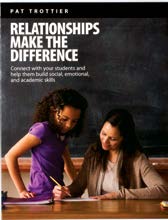
By Pat Trottier
Relationships Make the Difference goes well beyond how to establish parental support and communication. With its lessons and reproducibles on moral qualities like kindness, respect, empathy, fairness, self-control, tolerance and conscientiousness, it offers a wealth of helpful suggestions to meet socio-emotional requirements, and helps ensure the growth of enduring positive relationships among teachers, students and parents.
Building a strong bridge between home and school is one of the key diplomatic tasks of effective teaching. It’s easy to see that the high achievers in a classroom are usually those whose parents are deeply invested in their children’s education, providing the necessary discipline and boundaries to help a child learn.
And when that learning relationship with parents is cultivated by a teacher, it creates powerful supports around a student to grow — intellectually, emotionally and socially.
Leading your students toward social and emotional comfort zones is essential before they can experience academic success. It can even provide the motivation they need to pursue higher achievement. While delivering curriculum is important, the key to students absorbing and making sense of it is the fostering of their relationships with parents, teachers and peers.
With emotional and social needs in place, a teacher can help their students build skills. On a deeper level, that solid base will help children move beyond beliefs like they’re “stupid,” and help those who have unproductive behaviour and defeatist attitudes. Teachers must plan for these important needs and have strategies to address them.
Mary Veronica Moloney, OCT teaches Grade 3/4 at D’Arcy McGee Catholic School in Toronto.
Relationships Make the Difference: Connect with your students, and help them build social, emotional and academic skills, Pembroke Publishers, Markham, ON, 2016, softcover, ISBN 978-1-55138-314-9, 95 pages, $24.95, pembrokepublishers.com
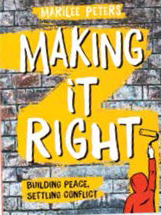
By Marilee Peters
Retribution and punishment are not the only ways to mete out justice. Restorative justice, truth and reconciliation, sentencing circles, conferencing and even pardons have all been explored in various cultures over time. Making it Right explores all those and more alternative approaches to conflict resolution.
The book opens with a critique of Western-style justice: its familiar systems of crime and punishment and its welldocumented statistics on incarceration and re-offence rates. A brief introduction to criminal philosophies and the neuroscience of empathy follows. Chapters focused on topics such as bullying, racial injustices, war crimes and corporate responsibilities form the bulk of the book. Throughout, Peters embellishes her narrative with memorable anecdotes, studies and case summaries.
The author argues that restorative justice is a more effective way to resolve conflict and promote healing for both criminals and their victims. She emphasizes the role of compassion and the important role youth have in developing strategies to re-establish peace.
Making it Right would serve as an excellent resource for teachers and students studying law, global issues or history. With its many references to the injustices of the Indigenous populations of Canada, the United States, New Zealand and Australia, it could accompany any exploration of Indigenous Studies. Furthermore, it might be used as an entry point for developing student-led programs or campaigns to resolve conflict and promote peace within local and global communities. The text is suitable for middle school students with the help of a facilitator, and could be easily grasped by senior students.
Natalie Munro, OCT, is a learning support teacher at St. Margaret’s School in Victoria, B.C.Making it Right: Building Peace, Settling Conflict, Annick Press, Toronto, 2016, softcover, ISBN 978-1-55451-809-8, 136 pages, $14.95, annickpress.com
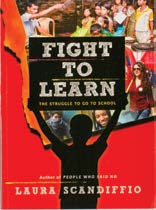
By Laura Scandiffio
The United Nations Universal Declaration of Human Rights says that everyone has the right to an education, and although the declaration also states elementary education should be free, millions of children worldwide are denied that basic privilege. Children seeking an education are faced with countless obstacles and challenges. Scandiffio delves into the stories of these children and tells young readers about the people who are fighting for the right to be educated.
Fight to Learn highlights the many obstacles faced by children throughout the world to getting an education, including poverty, discrimination and violence. Each section depicts a group of children who have been denied an education, and then introduces a person who has made a difference, either by raising awareness of the issues or starting a school of his/her own. The crisis in education is not just a developing world issue. Scandiffio includes timely chapters on the plight of Indigenous children in Canada and African- American children in the United States.
Suitable for children in Grades 5 to 9, the writing in Fight to Learn is engaging, and there are numerous colour photos throughout. Each chapter contains direct quotes and sidebars with relevant facts and figures; additionally, a comprehensive bibliography provides websites and articles that students can access for further research.
Bev Bellrose is a library technician at Sudbury Secondary School.
Fight to Learn: The Struggle to Go to School, Annick Press, Toronto, 2016, softcover, ISBN 978-1-55451-797-8, 176 pages, $16.95, distributed by University of Toronto Press, annickpress.com
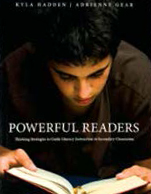
By Kyla Hadden and Adrienne Gear
Powerful reading is reading with thought and intent, so that the reader becomes metacognitive, or aware of their thinking as they read. Powerful Readers is a guide to teaching your students how to derive not only a literal understanding of their reading but how to extract real meaning and insight from the written word.
For fiction, connecting text with the reader’s own experiences, visualizing concrete images, questioning, inferring information that is not explicitly written, and transforming ideas that readers have about themselves, others and the world are all part of the process. For non-fiction, reading powerfully means making connections, focusing on important information, questioning, inferring, and synthesizing knowledge.
The book presents a balance of theory and practice and includes generic lessons, worksheets and rubrics to help teachers develop critical reading powers in their students. This revision of a decade-old classic instructional guide offers teachers new ideas and lessons as well as new anchor books to support powerful reading principles.
Teresa Ross, OCT, is a secondary school teacher with the Niagara Catholic District School Board.
Powerful Readers: Thinking Strategies to Guide Literacy Instruction in Secondary Classrooms, Pembroke Publishers, Markham, ON, 2016, softcover, ISBN 978-1-55138-313-2, 125 pages, $24.95, pembrokepublishers.com
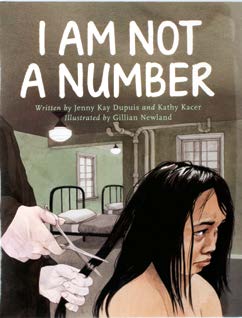
By Jenny Kay Dupuis and Kathy Kacer, Illustrated by Gillian Newland
First Nations people who were sent to residential schools have a heart-wrenching story to tell that may be difficult for many children to hear. So how do you go about telling it?
In I Am Not a Number an Indigenous educator, an award-winning author and an illustrator have collaborated to create a sensitive story about the plight of Jenny Kay Dupuis’s grandmother who, as a child, was sent to a residential school. There, she was stripped of her family, her hair and even her name, Irene. Known instead as number 759, she endured the harsh discipline and isolation of what those schools really were — factories designed to eradicate the heritage and culture of First Nations people.
The book supports the social studies curriculum requirement for students in Grades 6 and up to learn about the forced removal of First Nations and Métis peoples from their families. A picture walk in advance of the reading could help students formulate questions as they look at the sombre tones of the illustrations, the pained expressions on Irene’s family’s faces, the hand that cuts Irene’s hair and the harsh faces of her new caregivers at the school. Teachers could then read the text, pausing regularly to allow students to gather the contextual data supporting the images, to internalize and discuss it. Further questions may then be generated to deepen the inquiry. Is Irene a reliable source? Is the book a reliable depiction of history? I Am Not a Number is based on a true story and includes the nonfictionalized account of the real Irene. What other evidence can students look at to gather data?
Rereading I Am Not a Number after students have had the opportunity to gather other sources will give them the opportunity to evaluate and draw conclusions about the narrator’s perspective. What does that kind of early childhood experience mean for the identity and culture of First Nations, Métis and Inuit people? Though haunting and dissonant, educators must address Canada’s role in depriving a whole people of their heritage. Only by truly engaging with our past and talking with students about these injustices, can we embark on the journey together toward truth and reconciliation.
Jennifer Wyatt, OCT, is the junior school principal of The York School in Toronto.
I Am Not a Number, Second Story Press, Toronto, 2016, hardcover, ISBN 978-1-927583-94-4, 32 pages, $18.95, distributed by University of Toronto Press, secondstorypress.ca